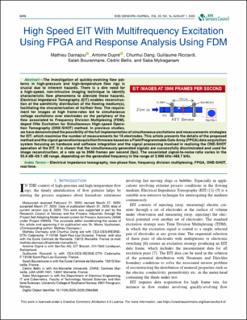| dc.contributor.author | Darnajou, Mathieu | |
| dc.contributor.author | Dupré, Antoine | |
| dc.contributor.author | Dang, Chunhui | |
| dc.contributor.author | Ricciardi, Guillaume | |
| dc.contributor.author | Bourennane, Salah | |
| dc.contributor.author | Bellis, Cédric | |
| dc.contributor.author | Mylvaganam, Saba | |
| dc.date.accessioned | 2021-03-09T10:31:04Z | |
| dc.date.available | 2021-03-09T10:31:04Z | |
| dc.date.created | 2021-02-26T10:09:36Z | |
| dc.date.issued | 2020 | |
| dc.identifier.citation | Darnajou, M., Dupré, A., Dang, C., Ricciardi, G., Bourennane, S., Bellis, C. & Mylvaganam, S. (2020). High Speed EIT With Multifrequency Excitation Using FPGA and Response Analysis Using FDM. IEEE Sensors Journal, 20(15), 8698-8710. | en_US |
| dc.identifier.issn | 1530-437X | |
| dc.identifier.uri | https://hdl.handle.net/11250/2732333 | |
| dc.description.abstract | The investigation of quickly-evolving flow patterns in high-pressure and higherature flow rigs is crucial due to inherent hazards. There is a dire need for a high-speed, non-intrusive imaging technique to identify characteristic flow phenomena to alleviate these hazards. Electrical Impedance Tomography (EIT) enables reconstruction of the admittivity distribution of the flowing medium(s), facilitating the characterisation of its/their flow. The requirement for images at high frame-rates led to simultaneous voltage excitations over electrodes on the periphery of the flow associated to Frequency Division Multiplexing (FDM), doped ONe Excitation for Simultaneous High-speed Operation Tomography (ONE-SHOT) method. In previous studies, we have demonstrated the possibility of the full implementation of simultaneous excitations and measurements strategies for EIT, which maximise the number of measurements for 16 electrodes. This article presents the details of the proposed method and the signal generation/acquisition firmware based on a Field Programmable Gate Array (FPGA) data acquisition system focusing on hardware and software integration and the signal processing involved in realising the ONE-SHOT operation of the EIT. It is shown that the simultaneously generated signals are successfully discriminated and used for image reconstruction, at a rate up to 3906 frames per second (fps). The associated signal-to-noise ratio varies in the 55.6 dB-69.1 dB range, depending on the generated frequency in the range of 3.906 kHz-468.7 kHz. | en_US |
| dc.language.iso | eng | en_US |
| dc.rights | Navngivelse 4.0 Internasjonal | * |
| dc.rights.uri | http://creativecommons.org/licenses/by/4.0/deed.no | * |
| dc.title | High Speed EIT with Multifrequency Excitation Using FPGA and Response Analysis Using FDM | en_US |
| dc.type | Peer reviewed | en_US |
| dc.type | Journal article | en_US |
| dc.description.version | publishedVersion | en_US |
| dc.source.pagenumber | 8698-8710 | en_US |
| dc.source.volume | 20 | en_US |
| dc.source.journal | IEEE Sensors Journal | en_US |
| dc.source.issue | 15 | en_US |
| dc.identifier.doi | https://doi.org/10.1109/JSEN.2020.2984388 | |
| dc.identifier.cristin | 1893948 | |
| cristin.ispublished | true | |
| cristin.fulltext | original | |
| cristin.qualitycode | 2 | |

